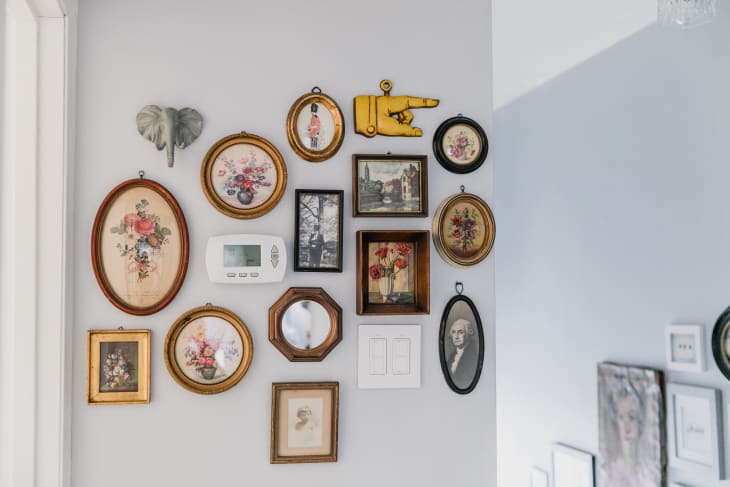How to Shop for Vintage Art Online So That You Get Exactly What You’re Searching For

Browsing a flea market can be a great way to shop for gorgeous vintage art. It’s easier to observe the work up close, and spot any imperfections or interesting layers. It’s also much easier to have a conversation with the seller.
But shopping for vintage art online can be a much bigger challenge. Dimly-lit photos can make it hard to see if a piece belongs in your home or if it’s worthy of your curated collection. Descriptions also might not tell the whole story, so you may think you’re ordering an original only to find out that it’s a sub-par copy.
Wondering what exactly makes a piece “vintage?” Amanda Morse, art category manager at vintage resale marketplace Chairish, says that art made within the last 30 to 100 years is categorized as vintage art. Anything older is considered “antique.”
In addition to Chairish, other great online destinations for vintage art include 1stDibs, Etsy, and eBay. You can also go the route of online thrifting from sources like Craigslist and Facebook Marketplace — but while the prices may be lower on those sites, you’ll have to sift even more critically since many of the listings haven’t been vetted by seasoned sellers.
If you’re a vintage die-hard who wants only the best for your collection, here are six expert tips for developing a critical eye when buying vintage art online.
Educate your eye.
Toma Clark Haines, CEO of The Antiques Diva & Co, likens shopping online for vintage art to attending a wine tasting — you drink the best wines first so that your palate can recognize quality. “When sourcing vintage art, look first for the best examples of your genre, even if they are over budget. By knowing what the best looks like, it will help you to recognize quality at lower price points when you find what you’re looking for.”
It can also help to research well-known artists if you’d like to aim for an authentic, curated collection, so you’ll know which aspects of their art to remember.
Look carefully at the photos and descriptions.
While you might be able to buy a boho basket or pottery online without being as discerning, art is a bit of a different story. Morse recommends paying close attention to item descriptions. “When you are looking for originals, check for a signature, date, and imperfections,” she says. In other words, things that should be listed when it’s real-deal, collectible art.
You’ll also need to look very carefully at the photos. Morse notes that even if you do spot imperfections here and there, like a torn canvas which can be expensive to repair, it could be “well worth it,” especially if it’s from a sought-after artist. Spotting those imperfections ahead of time will allow you to build the cost of repair into your budget. Plus, Morse says, “there’s something so special about art with a little patina and character.”
Ask questions.
When shopping for vintage art online, make sure there’s an opportunity to message the seller directly to ask questions.
Clark Haines says you can use these questions as a chance to learn about the history of a piece: where the seller found it, who it was purchased from, and if they happen to have a certificate of authenticity. If you’re particularly loving a piece, she also suggests asking if the seller has other similar items that may not be listed yet on their site. “It’s like having a virtual picker.”
Try negotiating.
You could also use the conversation with the seller to ask if there’s a chance of receiving a discount. Clark Haines says that asking “Is that your best price?” is a better way to negotiate a discount rather than asking for a specific number. “This is the perfect question because it allows the seller to offer the discounted price they had in mind,” she says. “And the price they had in mind might be better than the price you were willing to pay. What if you asked for 20 percent off when the vendor was willing to give 30 percent?”
She also stresses that it’s important to be respectful when negotiating. “Don’t make a ridiculous offer. Don’t ask for 80 percent off. By lowballing the dealer, they might just not give you any discount simply because you annoyed them. Remember, most sellers of vintage art are in this business because they love their inventory.”
Be sure before you purchase.
Many trustworthy online marketplaces have return policies, but it can vary seller to seller, which means there’s a chance you won’t be able to return the art if you’re not satisfied with it. That’s why it’s important to avoid this situation ahead of time.
“There’s nothing worse than getting a piece of art and finding out it’s too big or too small for your space,” Morse says. She emphasizes the importance of measuring in advance. “Take the extra time to tape out the measurements to really understanding sizing.”
Morse adds that Chairish has launched a feature on its iPhone app called “View In Your Space.” Through augmented reality technology, you can see how the art will look on your wall before you purchase it.
Buy what you love.
Ultimately, just buy what you’re drawn to and what you’ll love in your space — even if authenticity isn’t possible for every work you find.
“I always ask myself, ‘Do I truly love it?’ I pounce on pieces that I really adore and let that be my guide,” Morse says. She adds that great pieces are often overlooked due to ugly or dated framing, but if you love the art, you should focus on the work itself. “Hidden gems abound,” she says.